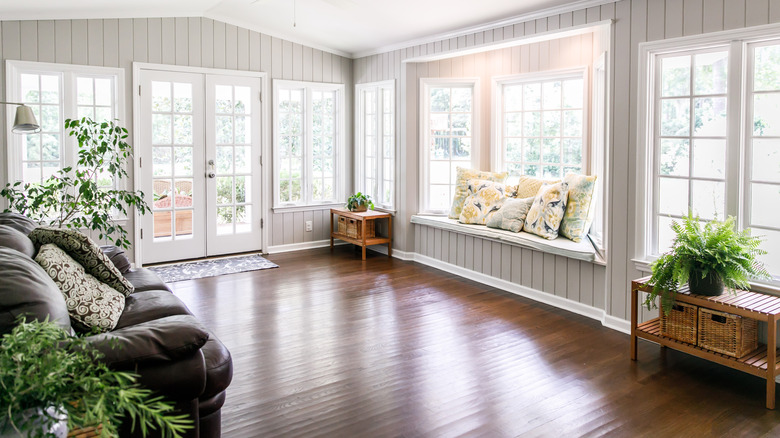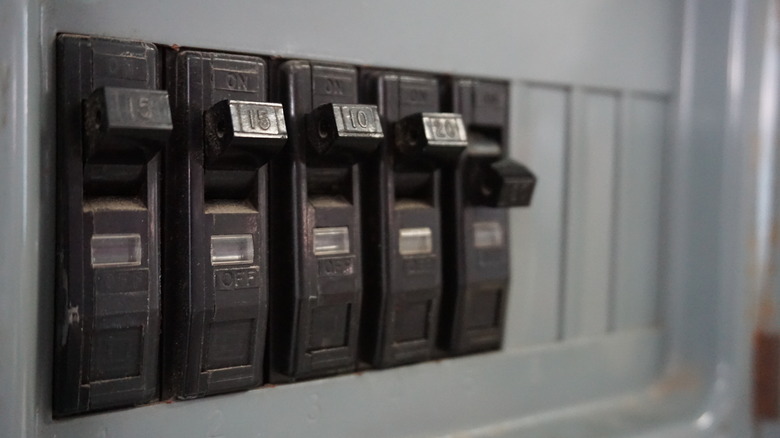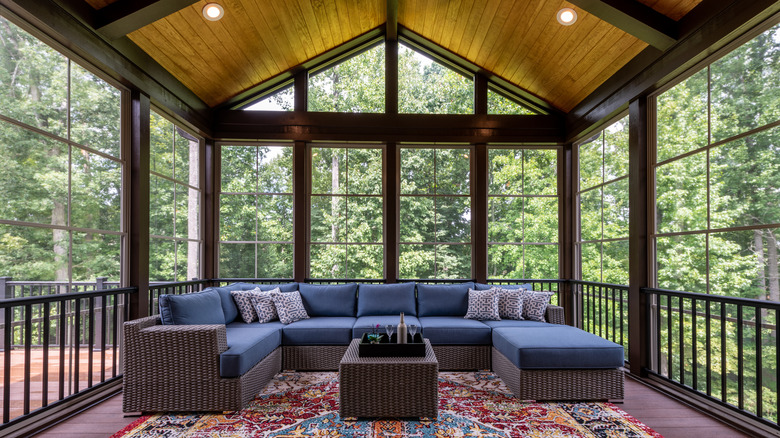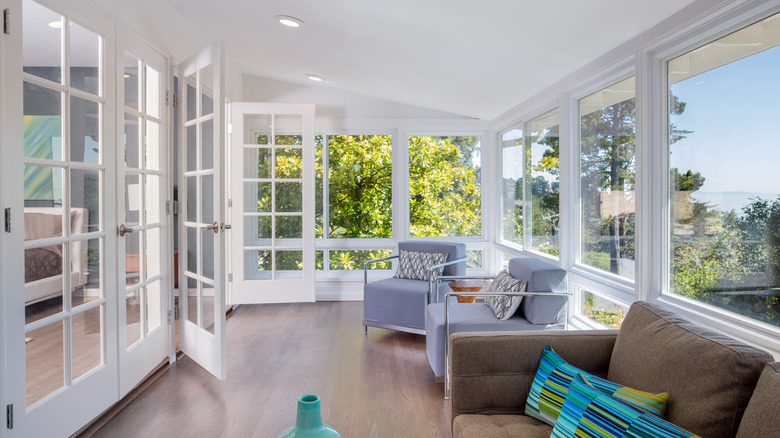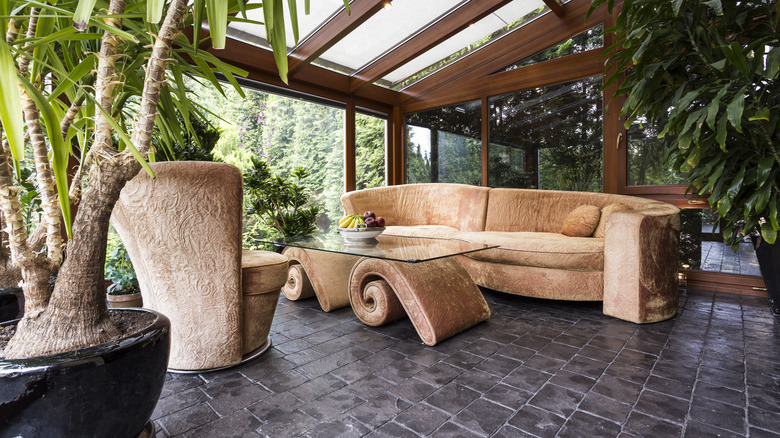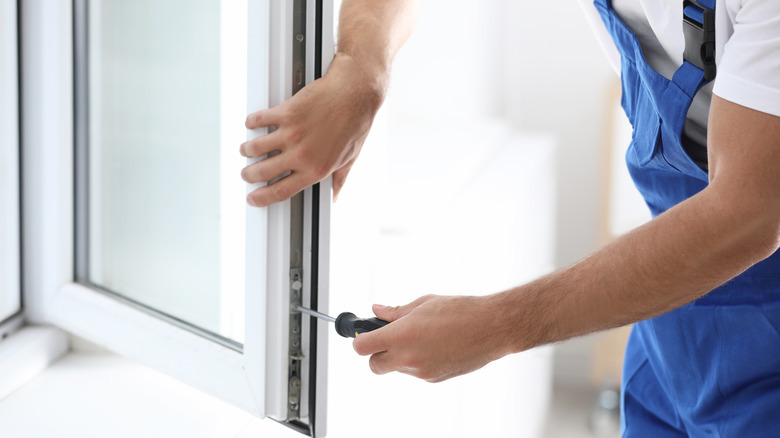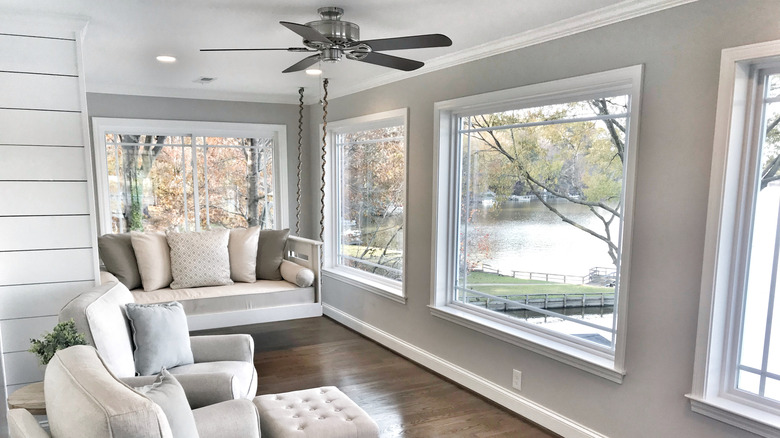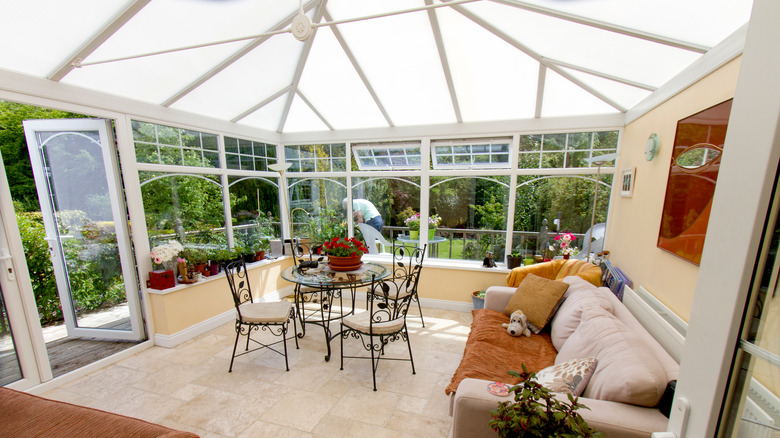Sunrooms: What To Know Before You Buy
Sunrooms are an excellent investment for your home. They provide additional space, a place to relax and enjoy the outdoor scenery, and can even increase your property value. Plus, there are many beautiful ways to decorate a sunroom. Thankfully, today there are plenty of pre-manufactured or prefab sunrooms that homeowners can add to their homes without the mess, cost, and time of building an addition from the ground up. According to LivingSpace Sunrooms, prefabrication enables buildings, homes, and add-ons like a sunroom to be portable and easy to build. This process helps keep errors to a minimum, unlike regular construction.
Prefab sunrooms look like an authentic home addition once installed. Plus, they offer many of the same options as a sunroom built from scratch. You can enjoy your sunroom during every season or only use it during certain times of the year. Either way, they're an ideal option for extra living space and relaxing and unwinding in your home. Ready to explore what to know before buying a sunroom? This guide will help you understand which sunroom suits your needs best and other considerations to keep in mind.
You should receive a free consultation
There are a few things to think about before adding a sunroom to your home. When searching for the best company to buy your prefab sunroom from, make sure they offer a free consultation. A consultation includes coming to your home, measuring, and discussing cost and selection. If a company doesn't have this necessary perk, then move on to the next. A good sunroom company wants you to know what you're getting.
According to Forbes, a new three-season sunroom could cost anywhere from $10,000 to $40,000, and a four-season could be as high as $80,000. With a range like that, a consultation is a must. You don't want to get your heart set on a specific sunroom and then find out it will cost thousands more than what you expected. A consult is a perfect time to take measurements at your home. Proper measurements are needed to help you choose the correct size sunroom. Even though you could probably measure yourself, a professional who deals with prefab sunrooms every day will know the ins and outs of the necessary measurements.
Make sure the sunroom has an approved wiring system
Wiring is a must-have in your new prefab addition. Make sure to ask if the total cost includes this feature. The price of some sunrooms is for just the room with elements like wiring costing extra. Heat, air conditioning, and outlets are other good features to bring into your new addition.
Another tip is to ask for a certificate showing it's an approved and safe wiring system. Electrical raceways are common for prefab sunrooms. According to Home Depot, an electrical raceway is a track with a metal tube that carries the electrical wiring along a surface or wall. The benefit of electrical raceways in a sunroom is that they let new wiring attach to an electrical receptacle within the house instead of cutting into walls to rewire. There's no mess and less expense. Keep in mind that electricity is not something to take lightly. Make sure it's professionally and properly installed. You don't want to head to your new sunroom for the first time and realize there's no way to read your favorite book at night.
The sunroom heats up in the summer
When someone purchases a sunroom, it's probably safe to assume they enjoy the sunshine. Still, keep in mind that a sunroom is almost all windows, which means an above-average amount of warm sun rays will be streaming inside. You'll need a way to cool the room down in the summer. According to New Age Air, installing a ductless mini-split system will effectively cool down the sunroom if you don't want to run your HVAC system to your new addition. Mini-splits run in just one room instead of cooling an entire home.
Another helpful idea is to install blinds or shades that raise up and down. These window treatments will let you keep your view and give you the option to block the sun. Also, consider a ceiling fan to help cool down your sunroom. Well-insulated windows are essential when you have a mini-split system since they ensure it runs efficiently. You can also consider tinting the windows in your sunroom to reduce warm temperatures.
The sunroom is cold in the winter
Your sunroom heats up in the summer, and it also attracts cold air in the winter. Sunny days help, but the cold temperatures will make you look for ways to add a little extra heat to your sunroom. According to Warmup, there are two main challenges when heating a sunroom. First, sunrooms are mostly windows, and glass is not a good insulator. With little insulation and cracks around windows, cold air quickly enters a sunroom. Second, most solutions focus on keeping out the cold air rather than heating the sunroom on the inside.
There are different options to heat your home and a chilly sunroom so you can enjoy it in every season. Consider insulating the floor and then adding rugs or carpeting. Some options that help cool the sunroom are also helpful for heating. A ductless mini-split heats a single room like a sunroom, and a ceiling fan, rotating clockwise, pushes the warm air down.
A sunroom will add value to your home
When you choose the correct sunroom, you're making a wise investment for your home. Sunrooms create additional space, and potential buyers and appraisers notice. However, you don't have to be preparing to sell your house to invest in a sunroom. According to Deco Alert, a sunroom doesn't just add monetary value. It also improves a homeowner's quality of life all year long.
The addition of a sunroom does more than offer sunshine and a beautiful view of the outside surroundings. It's an entire extra room you can use for anything you choose. For example, you can use your sunroom as a reading area or library, sitting room, playroom, exercise room, meditation space, birdwatching, or an extra room for entertaining. Like any home addition, a sunroom might change its purpose over time. You may need to use it as a playroom for a few years, but before you know it, the sunroom will be home to teenagers on Friday movie night. The possibilities are endless, but one thing is for sure: a sunroom adds value to a home in more ways than one.
Look for high-quality windows
In a sunroom, windows are everywhere you look. After all, that's the whole point of a sunroom. Look for high-quality windows so you'll enjoy a lifetime of use. NEXT Door and Window reminds us that sunrooms are made mostly of windows, so the windows we choose are more significant than in other rooms. These rooms are almost wall-to-wall glass. Rather than focusing on walls with a couple of windows, we're adding windows with very little wall space.
Talking with your sunroom contractor or installer is helpful when deciding on windows. Some homeowners want sliding windows with screens for fresh air when needed. Others prefer all glass and no screens, like a picture window, because they don't plan on opening the windows. Bay windows are ideal for some designs, and many homeowners choose the traditional double-hung windows. It all comes down to lifestyle and what a homeowner wants from their sunroom.
There are two types of sunrooms
Did you know that you can't just add a sunroom? You've got to choose the right type, and there's more than one sunroom style. According to Best Pick Reports, there are two kinds: three-season and four-season. The three-season sunroom usually requires less insulation, and the windows don't have to be as highly efficient as the four-season windows. The reason is that a three-season usually closes up shop during winter. Some homeowners prefer the three-season because they don't require heating. Instead, they enjoy their addition in spring, summer, and fall.
On the other hand, the four-season room stays open all year round and will typically need some form of heat and cooling method to be comfortable. Look for energy-star-rated windows for high efficiency for a four-season room. Also, make sure everything is well-insulated so that when winter comes around, the sunroom continues to be a well-used and cozy room.
Permit and approval
Whenever you create an addition to your home, you will usually need a permit from the city. According to Upgraded Home, any home addition with a roof or covering, like a sunroom, requires permits and should meet specific zoning requirements and laws. It doesn't matter how large or small the addition is. Either way, if there's a roof, there's a permit. They usually cost around $500, but every city is different. Contact your city to learn how much the permit costs and where to get it. Try not to put it off since these things can take a while, depending on where you live. You may be fined down the road if you build or add on to your home without a permit.
Additionally, if your neighborhood has an HOA (homeowners' association), it's wise to check the rules and regulations for additions. Your friendly neighbors may become unfriendly if they think you're breaking the rules.
Choose a sunroom company that offers a warranty
There aren't a lot of guarantees in life, but at least with a sunroom, you can get covered by a warranty if something goes wrong. According to Daily Press, a sunroom is an ideal addition to a home, but it can also become a disaster when not installed correctly or if accidents happen. Warranties are there to protect homeowners when disaster strikes. If you choose the right company in the first place, you limit the chances of sunroom failure.
Warranties for sunrooms cover things like broken glass on roofs and windows. It only takes one baseball to accidentally fly through your sunroom to make you thankful for a warranty. You don't want to pay to replace a window every year. Leaks or seals that aren't working let in cold air, which leads to inefficiency and higher heating bills. Siding issues can make the sunroom unattractive from the outside and affect the insulation. Life is messy. Talk with your manufacturer about the correct warranty for your sunroom.
You'll need to reduce glare
With so many windows, you'll want to take steps to reduce glare in your sunroom. Activities like watching television or reading become challenging when the sun reflects off everything. According to SFGate, east or west-facing windows tend to receive excessive sunlight during the hottest point of the day. Since sunrooms are mainly windows, you're bound to feel the effects of the sun's rays at some point. Thankfully, there are a few simple options to reduce glare from the sunlight.
For example, you can open an awning on the outside during the sun's peak hours. Shutters on the inside or outside are an attractive way to reduce glare and give your sunroom a cottage-style feel. Tinted glass is an option you can choose before installing the sunroom. You can also plant trees in the right spot to help shade and protect your new addition from glare. Just keep in mind that if you plant a small tree, it could be years before it helps you out.
Walk through model sunrooms first
Most prefab sunroom companies offer model rooms for customers to walk through. This option lets you get an authentic feel for the room before deciding. Just as you walk through a model home before building, it's essential to learn about your new addition. You may imagine a sunroom a certain way and then find that the layout or size doesn't suit your needs as you walk through. According to Pacific Patio, one sunroom may be a comfortable little nook while another is a large-scale home addition.
Be wary of a company that has no physical examples for you to see. Sunroom models should give you a clear picture of the quality of materials and possible upgrades. They should help you envision furniture placement. When searching for the perfect sunroom, keep the size of your house in mind. A tiny little addition to a mansion might look out of place. In the same way, a sunroom that's half the size of your home won't make sense.
Who will install your sunroom
You've chosen the perfect sunroom to purchase. Now what? If the company you're buying from doesn't install, you'll need to find a contractor or DIY. Adding a sunroom to their home is no small task for the average homeowner. Plenty of things can go wrong, causing damage to the sunroom or the house. A contractor who knows what they're doing is your best bet.
It can be tempting to save money by trying the installation yourself. The good news is that a sunroom is one of the least expensive ways to add to your home. According to Yancey Company, choosing a sunroom as an addition is the cheapest and easiest way to get additional living space in your home. The cost per square foot is about half of a standard room. With that savings in mind, consider adding a contractor to your budget. You're already cutting costs by choosing a budget-friendly home addition.
Which material is best for your sunroom
Once you finalize your sunroom type and size, it's time to choose the proper materials. According to The Spruce, most prefabricated sunrooms are aluminum, steel, tempered glass, or foam insulation, unlike a sunroom built from scratch with wood and drywall. Still, you'll need to choose flooring, wall coverings, and outside covering for your sunroom.
Many homeowners prefer vinyl flooring because there are many different options, including styles that look like wood. Vinyl resists moisture and cleans up easily. It's also less prone to scratches than authentic wood. Carpeting is a good option for those living in colder climates since it will warm up your sunroom in the winter. Paint works well for the walls, and you can easily mix it up when you're ready for a new look. Some homeowners use wood paneling to give their sunroom a cozy, cabin-style feel. For the outside walls, it's usually best to try to match your siding to your home, if possible. If your house is stone or brick, you have more options and can choose a siding that complements your home.
Gable, single-slope, or glass roof?
The roof is an essential aspect of your sunroom. Do you prefer the heat shining down from the sun, right into the sunroom? Or would you rather have a roof that protects you from the elements? Your roof determines how the sun will affect the sunroom. There are three main sunroom roof options: a gable roof, a single-slope roof, and a solarium. The gable roof is a classic look often seen on houses. According to Patio Enclosures, a gable roof usually has an angle of around 40 degrees, allowing snow and water to run down the sides. The gable roof also provides space for ventilation and a vaulted ceiling if desired.
The single-slope roof is a simple style, sometimes called a shed roof. This roof style is not as angled as a gable roof but does allow some water and snow to escape. The solarium roof is suitable for those who prefer an all-glass sunroom, with wall-to-wall windows and no walls. If you want sunshine from all angles, go for a solarium roof. This impressive style lets you watch the rain or stargaze at night.
